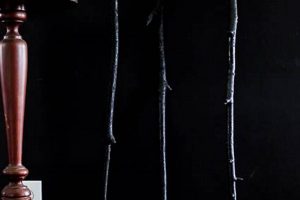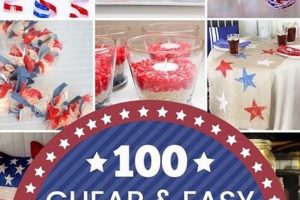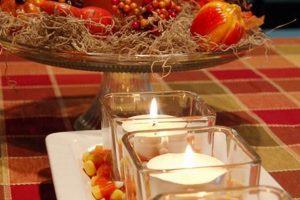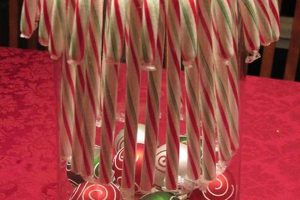Creating decorations for a wedding with limited financial resources, incorporating natural and simple elements reminiscent of the countryside, and executing these projects oneself defines a specific approach to wedding planning. An example of this could be crafting centerpieces using mason jars, wildflowers, and burlap, instead of purchasing elaborate floral arrangements.
This approach offers significant cost savings, allows for personalization that reflects the couple’s unique style, and fosters a sense of accomplishment through hands-on creation. Historically, couples have always sought ways to personalize their wedding celebrations, and adapting to financial constraints while emphasizing handmade touches is a recurring theme.
The following discussion will explore various aspects of this theme, providing practical ideas and guidance for those seeking to create an affordable and personalized wedding aesthetic.
Practical Guidance for Economical, Country-Inspired, Self-Made Wedding Embellishments
The subsequent advice aims to provide actionable strategies for generating aesthetically pleasing and affordable wedding decorations that evoke a rustic charm and are produced through personal effort.
Tip 1: Utilize Natural and Foraged Elements: Incorporating readily available materials from nature, such as branches, pinecones, and wildflowers, significantly reduces expenses. Ensure proper cleaning and preservation of these items before use.
Tip 2: Embrace Repurposed Materials: Mason jars, wooden pallets, and burlap sacks offer versatility and can be transformed into various decorative elements, including centerpieces, signage, and seating arrangements. Prioritize thorough cleaning and appropriate modification for safety and aesthetics.
Tip 3: Prioritize Simple and Elegant Designs: Opting for understated designs reduces the complexity of execution and minimizes material costs. Focus on clean lines and neutral color palettes to achieve a sophisticated rustic aesthetic.
Tip 4: Leverage Online Tutorials and Resources: Numerous online platforms offer detailed instructions and visual guides for crafting decorations. Thorough research ensures proper technique and minimizes errors, saving time and resources.
Tip 5: Plan and Execute Projects in Advance: Starting decorations well in advance of the wedding date allows for ample time to address challenges and avoid last-minute rushes, leading to better quality and reduced stress.
Tip 6: Incorporate DIY Lighting: Utilize string lights, candles in repurposed containers, or homemade lanterns to create a warm and inviting atmosphere. Adhere to all safety precautions related to open flames and electrical components.
Tip 7: Create Personalized Signage: Design and produce custom signage using reclaimed wood, chalkboard paint, or stencils to direct guests and add a personal touch. Ensure clear and legible text.
Tip 8: Focus on Key Focal Points: Concentrating efforts and resources on a few impactful decorative elements, such as the ceremony backdrop or reception tables, maximizes visual impact while minimizing overall expenditure.
Adopting these suggestions can result in significant cost savings, personalized aesthetic and a heightened sense of accomplishment in wedding preparation.
The ensuing conclusion will summarize the core aspects of this approach and emphasize the benefits of planning a self-made and rustic wedding.
1. Affordability
Affordability is a central tenet of any endeavor focused on achieving a “low budget rustic wedding decor diy.” It serves as the driving force behind material choices, design decisions, and the overall execution of the wedding aesthetic. The prioritization of cost-effectiveness guides every aspect of the decoration process.
- Material Selection
Affordability dictates the selection of inexpensive materials. Examples include using burlap instead of linen for table runners, repurposing glass jars as vases, and incorporating foraged natural elements like branches and wildflowers instead of purchasing elaborate floral arrangements. The cost differences are significant, allowing substantial savings without compromising the rustic aesthetic.
- DIY Labor Substitution
A core component of affordability is substituting professional services with do-it-yourself labor. By creating decorations independently, wedding expenses are dramatically reduced compared to hiring vendors. Invitations, favors, and centerpieces, crafted personally, represent tangible financial savings.
- Design Simplicity
Intricate and elaborate designs require specialized skills and expensive materials, which contravene the principle of affordability. Embracing simple, unadorned designs allows for cost-effective execution. Neutral color palettes, clean lines, and minimal embellishments contribute to a cohesive aesthetic while remaining economical.
- Strategic Sourcing
Affordability necessitates strategic sourcing of materials. Utilizing coupons, discounts, and bulk purchases can substantially reduce costs. Exploring thrift stores, flea markets, and online marketplaces provides access to affordable resources for wedding decorations.
In conclusion, affordability permeates every facet of planning decorations for a low-budget, rustic, self-made wedding. This strategic focus drives resourceful material selection, leverages labor substitution, promotes efficient design choices, and fosters resourceful sourcing practices, thereby allowing couples to realize their desired wedding aesthetic while adhering to strict financial constraints.
2. Simplicity
Simplicity is a crucial component of “low budget rustic wedding decor diy” due to its direct impact on cost, execution, and aesthetic coherence. Elaborate decorations demand extensive material resources and skilled labor, significantly increasing expenses. Conversely, simplified designs require fewer materials, reduce the need for specialized skills, and align with the unpretentious character of a rustic aesthetic, creating a harmonious and cost-effective outcome.
The correlation between simplicity and the DIY aspect is significant. Less complex projects are more accessible to individuals with varying skill levels, fostering increased participation and reducing the risk of costly errors. Examples include using single-stem wildflowers in repurposed mason jars instead of constructing elaborate floral arrangements, or opting for hand-lettered signage on reclaimed wood rather than professionally printed banners. These simplistic choices not only decrease costs but also enhance the personalized and heartfelt nature of the wedding.
Understanding the value of simplicity is practically significant for couples intending to minimize wedding expenses. By deliberately choosing unpretentious designs, they can leverage readily available materials, simplify the crafting process, and allocate their resources efficiently. This approach mitigates the financial burden associated with elaborate decorations while preserving the authentic charm of a rustic-themed wedding. Overlooking the role of simplicity often leads to escalated costs and a mismatch between the desired rustic aesthetic and the actual execution.
3. Natural Materials
The use of natural materials is intrinsically linked to the success of a “low budget rustic wedding decor diy” strategy. This connection stems from the inherent cost-effectiveness and aesthetic suitability of items sourced directly from the environment. The availability of elements such as wood, stone, foliage, and wildflowers in many regions provides a readily accessible and inexpensive foundation for wedding decorations. Employing these materials negates the need for expensive manufactured alternatives, thereby significantly reducing overall costs.
Furthermore, these materials contribute directly to the desired rustic aesthetic. The textures, colors, and organic forms of wood slices used as centerpieces, stone pathways lining outdoor spaces, or wildflower bouquets adorning tables impart an authentic, unrefined character that embodies the essence of a rustic theme. Examples include utilizing fallen branches to construct archways or repurposed wooden pallets to create seating arrangements. The very nature of these materialsunprocessed and evocative of the outdoorscreates an atmosphere that manufactured decorations struggle to replicate.
In summary, the deliberate integration of natural materials in the context of a low-budget, rustic, do-it-yourself wedding is not merely an aesthetic choice but a practical economic imperative. It allows for cost savings while simultaneously achieving the desired thematic consistency. This strategy represents a fundamental element for any couple seeking to execute a budget-conscious and stylistically harmonious wedding celebration.
4. Personalization
In the realm of nuptial celebrations, personalization assumes heightened significance when coupled with constraints of “low budget rustic wedding decor diy.” This intersection fosters opportunities for inventive expression and transformation of limited resources into meaningful representations of the couple’s identity and relationship.
- Handmade Elements as Storytellers
Crafted items contribute uniquely personal narratives to wedding decor. Instead of generic, store-bought decorations, elements crafted by the couple or their loved ones carry significance. Examples include hand-stitched table runners incorporating fabric from family heirlooms, or centerpieces featuring collected stones from significant locations, adding layers of depth and intimacy unavailable through commercial alternatives.
- Thematic Integration Reflecting Shared Interests
Personalization extends to thematic integration, with decorations reflecting shared hobbies, interests, or experiences. A couple who enjoys hiking might incorporate trail maps into table settings, or avid readers might use stacks of vintage books as risers for floral arrangements. This thematic coherence strengthens the connection between the decorations and the couple’s distinct identity.
- Custom Signage and Wayfinding
Personalized signage provides functional guidance while incorporating unique details. Instead of standard directional signs, couples might create hand-painted signs featuring inside jokes or references to shared memories. This approach transforms utilitarian elements into engaging components that reflect the couple’s distinctive style and relationship dynamics.
- Favors as Tokens of Appreciation and Identity
Wedding favors offer a final opportunity to personalize the experience for guests. Homemade treats, locally sourced honey, or seed packets for the couple’s favorite flowers provide tangible reminders of the celebration and represent the couple’s values. These personalized tokens extend the impact of the wedding beyond the event itself, leaving guests with lasting impressions of the couple’s thoughtfulness and individuality.
By embracing personalization within a “low budget rustic wedding decor diy” framework, couples can transform financial constraints into creative opportunities. This approach fosters a wedding aesthetic that is not only visually appealing but also profoundly meaningful, reflecting the couple’s unique story and creating a lasting impression on guests.
5. Resourcefulness
Resourcefulness forms the bedrock of successful implementation for “low budget rustic wedding decor diy.” It represents the capacity to identify and creatively utilize available assets, transforming potential limitations into opportunities for inventive and cost-effective decoration solutions. Without it, achieving an aesthetically pleasing and personalized wedding within budgetary constraints becomes significantly more challenging.
- Repurposing Existing Materials
The ability to repurpose existing materials constitutes a critical facet of resourcefulness. Items readily available in homes, attics, or from local sources can be transformed into decorative elements. Examples include utilizing old window frames as seating charts, repurposing vintage bottles as vases, or transforming fabric scraps into bunting. This approach reduces costs and adds a unique, personal touch, thereby embodying the spirit of resourcefulness.
- Leveraging Community Resources
Resourcefulness also entails tapping into community resources and networks. Borrowing decorations from friends or family, sourcing materials from local craft groups, or bartering services with other vendors can significantly reduce expenses. This collaborative approach fosters a sense of community involvement and mutual support, aligning with the inclusive nature of a rustic-themed wedding.
- Adapting to Seasonal Availability
A resourceful approach requires adapting to seasonal availability of materials. Utilizing in-season flowers, foliage, and produce for decorations is considerably more cost-effective than sourcing out-of-season items. This seasonal adaptation enhances the authenticity of the rustic theme and promotes environmentally conscious practices by reducing the carbon footprint associated with transportation and storage.
- Maximizing Functionality and Dual-Purpose Items
Resourcefulness extends to selecting decorative elements that serve multiple functions. Using blankets as both seating and warmth during an outdoor ceremony, or incorporating edible elements into centerpieces, maximizes utility and minimizes waste. This approach demonstrates efficiency and practicality, aligning with the pragmatic essence of resourcefulness.
These interconnected facets underscore the pivotal role of resourcefulness in “low budget rustic wedding decor diy.” By embracing repurposing, leveraging community networks, adapting to seasonal availability, and maximizing functionality, couples can surmount budgetary limitations and create a memorable, aesthetically pleasing, and personalized wedding celebration.
6. Handmade
Handmade decorations are fundamentally intertwined with the concept of “low budget rustic wedding decor diy.” The creation of decorations by hand becomes not only a stylistic choice but often a necessity to achieve the desired aesthetic while adhering to financial limitations. This approach requires a significant investment of time and effort, substituting monetary expenditure for personal labor.
- Cost Reduction through Labor Investment
The primary benefit of handmade decorations in this context is the direct reduction of expenses. Rather than purchasing commercially produced items, individuals invest their time and skills to create decorations, thereby eliminating retail markups and vendor fees. For instance, constructing centerpieces from foraged materials and hand-painted signage is significantly more economical than procuring these items from professional sources.
- Enhanced Personalization and Unique Aesthetic
Handmade decorations offer unparalleled opportunities for personalization. The ability to customize details, materials, and designs allows for a wedding aesthetic that uniquely reflects the couple’s preferences and relationship. Unlike mass-produced items, handmade decorations possess a distinct character and charm that contributes to a more authentic and memorable celebration. Consider hand-sewn bunting, unique stationery created at home, or personally crafted wedding favors.
- Control Over Materials and Design Consistency
Creating decorations by hand allows for precise control over material selection and design consistency. This control is particularly important for achieving a cohesive rustic aesthetic. Using reclaimed wood, natural fibers, and vintage elements contributes to a unified and authentic visual theme. Furthermore, this approach mitigates the risk of design inconsistencies often encountered when sourcing decorations from multiple vendors.
- Skill Development and Shared Experiences
The process of creating handmade decorations can also foster skill development and shared experiences. Couples and their loved ones may learn new crafting techniques, collaborate on projects, and strengthen their relationships through shared effort. These shared experiences become an integral part of the wedding narrative, enriching the overall significance of the event.
In essence, the handmade aspect of “low budget rustic wedding decor diy” transcends mere cost-cutting measures. It represents a conscious choice to prioritize personalization, authenticity, and shared experiences in creating a wedding celebration that is both visually appealing and deeply meaningful.
Frequently Asked Questions
The subsequent questions and answers address common inquiries and concerns related to creating affordable, country-inspired, and self-made wedding decorations.
Question 1: What are the most cost-effective materials for achieving a rustic wedding aesthetic?
Cost-effective materials include burlap, mason jars, reclaimed wood, wildflowers, pinecones, and other foraged natural elements. Sourcing these items locally or repurposing existing materials minimizes expenses.
Question 2: How can one balance cost savings with aesthetic quality when creating decorations?
Balancing cost savings with aesthetic quality necessitates focusing on simple, elegant designs, using readily available materials, and prioritizing key focal points. Attention to detail and thoughtful execution elevate the overall visual appeal.
Question 3: What are the most common mistakes to avoid when attempting DIY wedding decorations?
Common mistakes include underestimating the time commitment, attempting overly complex projects, neglecting safety precautions, and failing to plan adequately. Thorough preparation and realistic expectations are crucial.
Question 4: How can one ensure consistency in the style and theme of decorations throughout the wedding?
Maintaining consistency requires developing a detailed design plan, creating mood boards, and adhering to a limited color palette. Regular reviews and adjustments ensure thematic cohesion.
Question 5: What safety precautions should be taken when working with DIY wedding decorations, especially those involving lighting or open flames?
Safety precautions include using flame-retardant materials, properly securing electrical wiring, providing adequate ventilation, and never leaving open flames unattended. Compliance with local fire codes is imperative.
Question 6: How far in advance should one begin planning and creating DIY wedding decorations?
Planning and creating decorations should begin several months in advance of the wedding date, allowing ample time to address challenges, refine designs, and avoid last-minute stress. Starting early is critical for successful execution.
These answers provide guidance for those seeking to navigate the challenges and opportunities associated with crafting their own wedding decorations.
The following section provides a checklist to review before starting to plan a DIY wedding.
Conclusion
The preceding discussion explored the various facets of “low budget rustic wedding decor diy,” emphasizing the pivotal role of affordability, simplicity, natural materials, personalization, resourcefulness, and handmade elements. Successfully implementing this approach requires meticulous planning, creative adaptation, and a commitment to prioritizing meaningful details over extravagant displays. A strategic focus on cost-effective material sourcing, efficient labor allocation, and deliberate design choices is essential for achieving a visually appealing and thematically coherent outcome.
As couples continue to seek increasingly personalized and budget-conscious wedding celebrations, the principles outlined within this analysis offer a framework for achieving these objectives. Adherence to these guidelines facilitates the creation of a unique and memorable wedding experience, reflecting the couple’s individual style and values without incurring excessive financial burden. Further exploration and refinement of these strategies will likely yield even more innovative and accessible solutions for future wedding celebrations.







